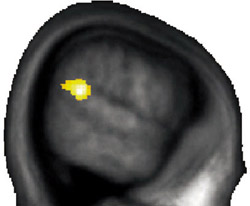The more gray matter you have, the more altruistic you are

The junction (yellow) between the parietal and the temporal lobes, in which the relative proportion of gray matter is significantly positively correlated with the propensity for altruistic behavior. UZH<br>
Why are some people very selfish and others very altruistic? Previous studies indicated that social categories like gender, income or education can hardly explain differences in altruistic behavior.
Recent neuroscience studies have demonstrated that differences in brain structure might be linked to differences in personality traits and abilities. Now, for the first time, a team of researchers from the University of Zurich headed by Ernst Fehr, Director of the Department of Economics, show that there is a connection between brain anatomy and altruistic behavior.
To investigate whether differences in altruistic behavior have neurobiological causes, volunteers were to divide money between themselves and an anonymous other person. The participants always had the option of sacrificing a certain portion of the money for the benefit of the other person. Such a sacrifice can be deemed altruistic because it helps someone else at one’s own expense. The researchers found major differences in this respect: Some participants were almost never willing to sacrifice money to benefit others while others behaved very altruistically.
More gray matter
The aim of the study, however, was to find out why there are such differences. Previous studies had shown that a certain region of the brain – the place where the parietal and temporal lobes meet – is linked to the ability to put oneself in someone else’s shoes in order to understand their thoughts and feelings. Altruism is probably closely related to this ability. Consequently, the researchers suspected that individual differences in this part of the brain might be linked to differences in altruistic behavior. And, according to Yosuke Morishima, a postdoctoral researcher at the Department of Economics at the University of Zurich, they were right: “People who behaved more altruistically also had a higher proportion of gray matter at the junction between the parietal and temporal lobes.”
Differences in brain activity
The participants in the study also displayed marked differences in brain activity while they were deciding how to split up the money. In the case of selfish people, the small brain region behind the ear is already active when the cost of altruistic behavior is very low. In altruistic people, however, this brain region only becomes more active when the cost is very high. The brain region is thus activated especially strongly when people reach the limits of their willingness to behave altruistically. The reason, the researchers suspect, is that this is when there is the greatest need to overcome man’s natural self-centeredness by activating this brain region.
Ernst Fehr adds: “These are exciting results for us. However, one should not jump to the conclusion that altruistic behavior is determined by biological factors alone.” The volume of gray matter is also influenced by social processes. According to Fehr, the findings therefore raise the fascinating question as to whether it is possible to promote the development of brain regions that are important for altruistic behavior through appropriate training or social norms.
The study is a part of the larger research program “Neurochoice”, a project initiated and financed in part by SystemsX.ch
Literature:
Yosuke Morishima, Daniel Schunk, Adrian Bruhin, Christian C. Ruff, and Ernst Fehr. Linking brain structure and activation in the temporoparietal junction to explain the neurobiology of human altruism. Neuron. July 12, 2012.
Contact:
Prof. Dr. Ernst Fehr
Department of Economics
University of Zurich
Tel.: +41 44 634 37 01
Email: ernst.fehr@econ.uzh.ch
Yosuke Morishima, M.D., Ph.D
Department of Economics
University of Zurich
Tel.: +41 44 634 51 69
Email: yosuke.morishima@econ.uzh.ch
Media Contact
More Information:
http://www.uzh.chAll latest news from the category: Studies and Analyses
innovations-report maintains a wealth of in-depth studies and analyses from a variety of subject areas including business and finance, medicine and pharmacology, ecology and the environment, energy, communications and media, transportation, work, family and leisure.
Newest articles

Making diamonds at ambient pressure
Scientists develop novel liquid metal alloy system to synthesize diamond under moderate conditions. Did you know that 99% of synthetic diamonds are currently produced using high-pressure and high-temperature (HPHT) methods?[2]…

Eruption of mega-magnetic star lights up nearby galaxy
Thanks to ESA satellites, an international team including UNIGE researchers has detected a giant eruption coming from a magnetar, an extremely magnetic neutron star. While ESA’s satellite INTEGRAL was observing…

Solving the riddle of the sphingolipids in coronary artery disease
Weill Cornell Medicine investigators have uncovered a way to unleash in blood vessels the protective effects of a type of fat-related molecule known as a sphingolipid, suggesting a promising new…





















